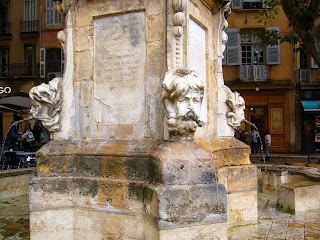Some time ago I booked a study visit to the textile collection at Gawthorpe Hall, in Lancashire. This is the second largest collection of embroidery in the country and was established by Rachel Kay-Shuttleworth, whose family owned the hall. Now the hall is administered by the National Trust and the local council, but the textile collection is a separate enterprise. I went on Wednesday of last week. Rachel Terry, the Curator, and her team had already chosen relevant items for me to examine. They were very helpful in suggesting further leads.
So what was it that made me embark on this trip - after all, I live in Essex and it is a five-hour journey there, involving four trains and a taxi. Well, in 1991 my husband and I holidayed in Brittany, in a gite. One day we drove to Vannes, a sea-port, to take the boat out to one of the islands in the gulf of Morbihan. As we wandered through the town I spotted a brocante with some textile items for sale. I had in mind one of those lace coifs traditional to the area. However, these were eye-wateringly expensive. A much larger item was bundled up on an outside table. The shopkeeper seemed keen to sell it to me at a discount, but we were about to go on a boat-trip so I hesitated.
What would you have done?
 |
| The reverse of a section of my coverlet |
As we sat eating lunch at the harbour, I just knew that I had to have the item so I rushed back to the shop, bought it and parked it in the car. That evening I unfolded it in the gite. It was very large, and covered all over in very elaborate embroidery. It was so large that it was difficult to take in, and the embroidery was white on white, so it needed close study.
Over the years I have gathered expert opinions on the piece. It is a double bed size quilt, constructed without any wadding but with cording outlining the flower motifs. It is very densely embroidered and of a very high standard of workmanship. It is clearly an early piece - but how early?
 |
| Copyright Cheviots.blogspot.com. |
I visited Gawthorpe in order to examine other examples of corded quilting. I was able to spend some time looking closely at a wonderful piece edged in heavy lace. This was said to have been a panel for a quilted petticoat in the eighteenth century, reused as a table cover. I was intrigued to see how much it had in common with my item, and how it differed. I would like to thank Rachel and her team for all the help that they gave me.
 |
| Copyright:Gawthorpe Textile Collection. |
After a fascinating afternoon examining the Gawthorpe items with a magnifying glass, it was back to the taxi and the four trains to get home again.
My plan is to try replicating a very small motif from my item to understand the technique better. I'll be planning a visit to the new study collection at Olympia to see what the V&A has in store. And I will be taking my time, because the coverlet itself is not in a hurry.




















.JPG)